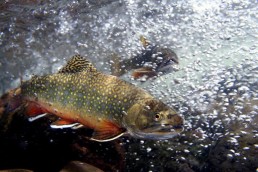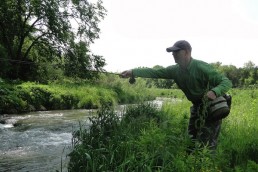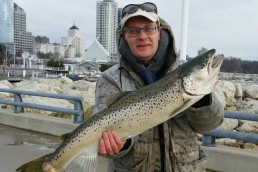Change things up for Low-water Summer Trout
SHARE THIS POST
Starting in June, trout fishing changes. From the high and cooler waters in that early season, we go to low and much warmer water. This means that we better change our fishing styles if we still want to catch trout.
This is about the time of year when I go to the fly rod. Both wet and dry flies work well. That being said, there are still times in the summer when there’s low water and I use spinners. You can use spinners with a fly rod, and many times after fishing upstream with flies and possibly not having the best luck, I will tie on a zero Red and White Mepps or a Black and Gold Panther Martin and head back downstream.
If the stream is wide enough, you can toss the spinner out in front of you. Then you can bring it back by bringing your rod to one side all the way behind you, reel in a little of the line and do it again. I do that occasionally, but usually just wade downstream until I come to a rapids. I flip the spinner into the rapids and let the current of the rapids make it spin, paying out line slow enough that the spinner keeps spinning all the way through the rapids. Many times the spinner will not even get halfway through the rapids before a trout takes it.
If the spinner makes all the way through the rapids, I hold it at the very tail of the rapids letting it current continue to spin it. Normally I will let it stay in that position for about a minute. After that, it is time to bring the spinner back through the rapids. I do this by pulling it about six or eight feet toward me, and then reeling up the loose line. The current will not let you get all of the line that you have pulled out, but that is quite all right. Many times I get a trout on the retrieve.
Depending on what type of stream you are fishing, some of your tactics will vary. If you are fishing a stream with a lot of brush and trees along the bank, you will have to use different tactics than if you are fishing a pasture stream with almost no cover. On the pasture streams you will strictly look for deep holes, undercut banks and rapids. Here you need to be very careful that the trout do not see you and that you do not make any excessive noise. With the brush and tree covered banks you will have a lot more choices.
Under overhanging brush, the water will be cooler than in midstream. This is a good place to place your fly. Another great spot is under tree roots. Many times you will see a tree right at the edge of a stream with the roots exposed. If you can get your fly close enough and float it past correctly, you will have a great chance of getting a trout. There will also be trees down in the water and other obstructions in this type of stream. All of those are excellent trout holding areas.
Are you enjoying this post?
You can be among the first to get the latest info on where to go, what to use and how to use it!
There are other little tricks that you can use. Have you ever been caught near a trout stream and have a spinning rod along when you needed a fly rod? I personally carry a few flies in all of my tackle boxes as well as a few spinners in my fly fishing equipment.
Casting and fishing with flies with spinning or spincasting equipment is just as simple as throwing spinners with a fly rod, maybe even easier. I never use a casting bubble. I have tried them and found that I could not get the proper action from my fly using them. Instead, I get a small piece of twig from a nearby bush and tie that on my line as a casing weight. I usually tie it about a foot above the fly. I then cast upstream and let it float back to me reeling up the line just fast enough to keep most of it off the water, but not fast enough to interfere with the natural float of the twig and fly. This is a great method especially with a dry fly. To a trout, I feel that it looks natural to see a piece of twig floating down the stream. The fly should appear to be just something that fell off the twig and is floating along with it. Whether that is actual fact or not I am not sure as I have never been a trout, but I have caught numerous trout using that method.
Another, what some may call strange, method I use is something I have written about before and that is stirring up the water. The method is, when you are fishing downstream, to go to the edge of the stream and stick your foot in some mud. Let a cloud of that mud float downstream. When it gets to about the far range of your casting ability, cast your fly or spinner into the leading edge of the mud cloud. If you are using a spinner, retrieve it through the cloud. If you are using a fly, pay out line for 10 to 20 yards, letting the fly remain in the cloud before retrieving it. I learned this one day when I decided to step out of the stream I was fishing.
I was still smoking at the time and decided it was time for a smoke. As I stepped out of the stream, I kicked up that cloud of mud and as I lit my smoke, I stood watching it float downstream. I figured, oh well, it should clear up by the time I finish my smoke. Then I noticed something happening, there were little dimples coming up in the cloud. There were fish in there feeding on whatever I had kicked loose with the mud. It did not take me long to have a spinner in the cloud and it no more than hit the water that I had a brookie on.
That time was accidental but I have done it many times in the years since. I have done it with both flies and spinners. If you think about it, when a deer crosses a stream, they always kick up mud clouds so the trout are used to seeing them. When the water is low, there is not as much natural food washing into the stream as when the water is high so the trout take advantage of any that comes along.
Sometimes it takes a little thinking out of the box to catch trout at all times of the year. Just because a method seems a little strange or you have been told it will not work, try it anyway. The day I first kicked up the mud, I had not caught a trout up until that time. By the time I got back to the car, I had limited out. So go on out and try something new. Many fishermen quit fishing trout when the water gets low and warm. That just leaves more space and trout for me. Try low water fishing; you just might enjoy it.
MWO
SHARE THIS POST
Did you enjoy this post?
You can be among the first to get the latest info on where to go, what to use and how to use it!



